UPDATE #3 DEC 2022
There do seem to be anecdotal (not very well corroborated) stories of British POWs being herded onto a bridge during an Allied air raid in an effort to deflect that attack. The precise place and timing is not clear. I refer to this as anecdotal in that it seems quite unlikely that such a maneuver could have any hope of success. At the altitude and speed that a bomber is approaching it would hardly be possible for them to discern what was happening on their target below except for the passage of a train. Bombers of the era would release their bombs before they passed over the actual target. Those bombs would then free-fall on a trajectory towards the target. Prior to releasing the bombs, there would not be a pass-over of such a target to determine its status = note the presence of hostages.
Furthermore, a recent discussion of the topic of the Nationalist Chinese military presence on the TBR came to the conclusion that there is no evidence to support such a claim. There was never a significant Chinese military presence in Thailand. The IJA did maintain a garrison in the far north to guard against such an intrusion, but none is recorded to have occurred.
There were thousands of Chinese who fought in the Burma Theater. Perhaps the cited events occurred there. Why there would be such a cross-over or mis-identification of a Nationalist Chinese military presence on the TBR is unclear. Who would benefit from such a falsehood?
UPDATE #2 SEP 2021
I have just received new translations of the two plaques at this Memorial. The one labelled as NARRATIVE is essentially the same content as the earlier translation shown below and claims that there were Chinese Military POWs at Kanchanaburi and that some were used as human shields.
The newest translation entitled A LONE MILITARY varies only slightly from that posted below. Also posted here is a different view of the Chinese language plaque as it exists today; perhaps a bit easier to read.
Narrative of the Monument
During the Second World War, China’s Expeditionary Force suffered more than 100,000 casualties in Southeast Asia, and most of the fatalities occurred in the Burma theatre. However, more than 30,000 prisoners-of-war were brought to Thailand to work on the River Kwai Bridge and the Death Railway, and here they died of hunger, disease, exhaustion, and ultimately were killed. They all died, and then were forgotten….
In the war museum on the other side of the river, the following paragraph of text can be found: “In order to block Allied aircraft from bombing the bridge, the Japanese military forced the prisoners of war onto the bridge to act as a human defense line. It is not certain how many bombs were dropped in this intensive bombing, but more than 300 men were killed on the spot; the river below turned red within an instant and the corpses sank slowly to the bottom of the river. None floated away, and there was no one to drag bodies out of the water. The river water became foul-smelling, and no one dared drink it for a long time. The dead were all Chinese…” That, in a few words, describes this tragic scene with so much reeking of blood.
Sixty years have passed, and these Chinese soldiers who sacrificed themselves for the peace of mankind are being honored by no one. But there was an unknown, very ordinary Thai woman who sold her house and property and used the funds to build a memorial for these forgotten Chinese soldiers…, and that is this memorial, like a swordsman touching the sky, standing on this bomb crater where more than 300 Chinese soldiers were blown up. This is known as the “Chinese Expeditionary Force Memorial”, or “The Monument to Those that Were Lost in the Bombing”, or the “Chinese Military Memorial”, but it actually is a memorial to Thai-Chinese friendship, it is a monument of sympathy for all those who oppose war. Later, the Thai woman personally constructed the “Tomb of the Lone Military”, and suffered poverty, sickness and exhaustion.
The Chinese people and those people who love world peace will remember this kindhearted Thai woman. Her name is Wannipa Kuandueng.
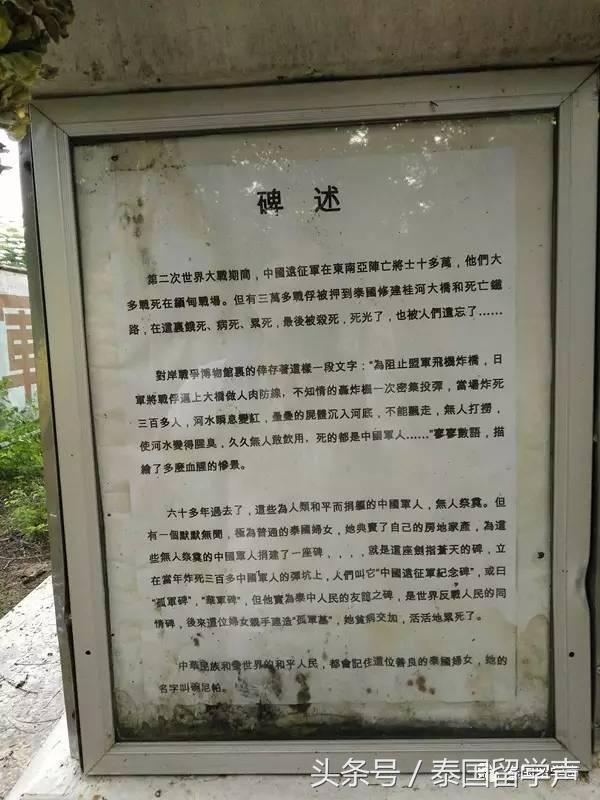
This raises a number of questions in that to date I have not been able to corroborate this claim of a Chinese military presence in this area. Two forays into POW sites on the internet seem to strongly suggest that this is a completely fictional scenario. IOW, there WERE NO Chinese military POWs and certainly no human shields.
Once again, we are forced to ask why some one ( Wannipa Kuandueng ?) would go to such lengths to perpetrate a hoax. This is compounded by the simple fact that this memorial was originally on the river bank and then was moved farther inland when the Chinese-style temple (Wihan Phra Photisat Kuan Im) was built. These two compounds remain separate and I have found no connection between them except that they are both related to Chinese events.
It appears as though we have another mystery related to this era. There appears to be no overlap with the Allied POW story, but exactly why and by whom this memorial was erected is still unknown. If the reference to the 60th anniversary of the end of WW2 is to be believed then the construction data was 2005.
A Lone Military
The Sixtieth Anniversary of the End of the Second World War
In 1941, the Japanese military bombed Pearl Harbor, and this incited the Second World War.
In January of 1942, China, the United States, England, France, and Russia, among a total of 26 nations, declared war on Japan in Washington, D.C. The international war situation at that time was critical – Nanjing had fallen, and most of the war zone in China was occupied by the Japanese military. Southeast Asia was also occupied by the Japanese military, and the Japanese military had taken a great many prisoners of war. At the cost of more than one hundred thousand lives, they constructed the bridge over the River Kwai and the Death Railway, and completed strategic preparations for an attack on South Asia.
From January 15-20, 1942, the Japanese military concentrated four divisions (the 55th, 18th, 56th, and 38th), with more than one hundred thousand troops, at the south side of the River Kwai Bridge, and prepared to move north. At that time, the allied force defending India and Burma did not have enough strength to resist, so they requested help from the China war area. China, under extremely difficult conditions, sent three hundred thousand troops to assist its English and American allies, and actually became the main force resisting Japan in the South Asia. This then became the only time in its history that the Chinese people responded to the request of the world’s people for help and sent its famous Chinese Expeditionary Force.
The vanguard unit of the Expeditionary Force set off in February 1942 on its way to defend British positions. But, because of transportation difficulties, its back-up couldn’t keep up, and when it entered the Taunggoo district of northern Yangon on March 7, the Japanese military had already started its attack on Yangon. On March 8, the British military abandoned Yangon, and in this unstable situation, the vanguard unit of the Chinese Expeditionary Force quickly engaged the Japanese enemy on the battlefield. After four nights of bloody battle, both sides had suffered great casualties. The battle for Taunggoo had been a blow to Japanese morale. If reinforcements for the Chinese side had arrived on time, the Expeditionary Force could have taken advantage of the circumstances and recovered Yangon – but unfortunately, they were late. With the advantage of the River Kwai Bridge and the Death Railway, the Japanese military could greatly increase its strength. By moving north on three roads, the Japanese cut off the reinforcement routes for the Expeditionary Force, thereby rendering the Expeditionary Force a lone military force that would engage in a bloody battle to the death.
Burma was the focus of the South Asia battlefield, with battles at Taunggoo, Renanguang, and Mizhina. In order to destroy the ability of the Japanese to continue receiving reinforcements, surprise attacks on the River Kwai Bridge never ceased. China’s expeditionary force worked with its British and American allies in continuous battle and hardship for three years. In August, 1945, the 93rd Division of the Expeditionary Force, representing the Allied Forces, accepted the surrender of the Japanese forces at Longponabang. The war in South Asia, as part of the Second World War, had come to an end.
As the world welcomed peace, mausoleums, memorial plaques and other commemorative structures were placed at the River Kwai Bridge area. At the same time, China was experiencing its civil war, and later, its military withdrew to Taiwan, and the Expeditionary Force became a roaming lone military, lost to history and forgotten by people. They became lone ghosts wandering in the night, moving through the mountains and valleys of South Asia. No one built a grave or erected a plaque for them. One hundred thousand officers and men had lost their lives, and their great achievements had become clouds of smoke in the sky…
Yes! The lone military!
This year is the 63rd anniversary of the start of the Second World War, and is a period of celebration of the 60th anniversary of the end of the Second World War. More than half of the world has passed on, and there is still no plaque or grave to commemorate China’s Expeditionary Force, which spilled so much blood on the ground of South Asia. We can only use this short oratory to show our respect for these brave heroes…
May they rest in peace!
May they be relieved from their suffering!
Always remember the lone military force!

It seems as if we do NOT YET know the whole story behind this rather obscure and unique memorial.
As noted in the NARRATIVE, I suspect that this was a privately-funded undertaking = no involvement by the Taiwanese gov’t. And that it most likely is linked in some fashion to the larger Chinese temple; although I have no proof of such. The fact that the Wihan Phra Photisat Kuam Im has an almost nonexistent electronic footprint is also odd, if not suspicious.
UPDATE #1
I’m going to leave the earlier posting below in place, but I believe that we have at least a partial answer to the conundrum of what does it memorialize? Why is it there?
I believe that we can safely state that there were NO Chinese military POWs who worked the TBR. There is also no suggestion that any mainland (homeland?) Chinese were present either. Any ethnic Chinese who were hired (impressed) on to the TBR came primarily from Malay / Singapore.
As to the origin and validity of the PANTIP URL story of POWs and 300 human-shield deaths, these seems to be ZERO corroboration of any aspect of that fairy tale. WHY someone would wish to concoct such a mythical story is quite beyond my perception.
As I noted in the posting below, I was skeptical all along, but when I see something in original script (Thai) with an on-line translation purporting to be a translation of the plaque at the actual memorial, I feel compelled to look deeper into the subject even if it seems quite far-fetched. My ‘investigation’ found NOTHING to even remotely uphold the PANTIP posting’s story-line.
It DOES seem that the memorial as it sits on the hill behind the temple is dedicated to the Chinese soldiers who fought the IJA in and around Burma — and possibly in northern Thailand as well — but it then has nothing what so ever to do with the TBR itself. Why THAT memorial is in THAT place is something of a mystery. One could ascribe all sorts of nefarious motives, but I’ll await confirmation before I point any accusing fingers. The texts and photos that accompany the memorial are quite a mish-mash of TBR- and WW2-related stories that seem to have little on no connection to the purpose of the memorial itself.
It is still a confusing state of affairs and ANY additional insight would be appreciated. Use the COMMENTS section below to add content or commentary.
ORIGINAL POSTING
This is proving to be a mystery. On the opposite bank of the river from where most tourists view the River Kwai Bridge, is a large temple. Hidden away behind Wat Thung Samo is what is known simply at the Chinese Soldier Memorial.
But WHAT does it memorialize? Why is it there? I did find this tantalizing reference of dubious credibility. Is it factual or full of mis-information?
It generally arrives in Thai script, but there is a translate pop-up that often accompanies it. Here is the main section:
“The message written beside the monument reads: narrative of the inscription in World War II of Chinese soldiers who went to war in Southeast Asia have died over a hundred thousand Most of them died in battle in Burma, but was taken prisoner to build a railway at the bridge over the River Kwai In Thailand, about 30,000 people die of hunger, disease, fatigue and when they all die It was all forgotten by us.
On the opposite side of the museum, there is still a message left in one section that reads:
“In order to prevent the bombing of the bridge of allied aircraft The Japanese soldiers forced the prisoners to become human shields on the bridge. But on one occasion, the Allied aircraft dropped a powerful bomb without knowing it. Three hundred people were blown up and killed. until the river turns red and the bodies drowned in layers in the river There were no cars floating around and no one came to help collect the bodies, causing the river to stink with blood, causing no one to dare to bring water for consumption. The dead bodies were all Chinese soldiers.”
Sixty years later, the Chinese soldiers had sacrificed themselves for the peace of mankind. No one has ever made merit, but there is a Thai woman who is an ordinary villager. She has sold the property of her house. to bring money to build a stone inscription pointing to the sky that sits on the tomb of more than 300 Chinese soldiers so we call it “Inscription of Chinese soldiers invasion”, also known as the “Inscription of a lonely soldier” , but in fact, it is an inscription of Thai-Chinese friendship. It is a stone of the people’s resistance against war.
In the end, this woman built a lonely soldier’s tomb. “This by myself until I die because both until the disease and tiredness in the end Chinese people and peace-loving people around the world remember the woman’s name. Her name is Wannipa Kuandueng.”

[the above is the translation of the Thai language inscription as provided on-line]
This inscription seems to suggest that there were up to 30,000 Chinese military POWs who worked the TBR. When they were positioned near the bridge is not clear. Were they there with COL. Toosey’s force that built the two bridges? The description of the bombing for which they were human shields is likely that of an AZON-bomb attack which took place later in the war in 1945. That would place these POWs in the consolidated POW camps near the Bridge.
I, personally, have seen no other reference to Chinese soldiers as POWs on the TBR. Indeed, many workers of Chinese origin are known to have worked the TBR under the overall heading of the romusha. It is assumed that most of these were Malays of Chinese heritage, There seems to be no other references to Chinese military POWs.
Could there have been as many as 30,000 captured soldiers without a historical reference to such? Could 300 have died in a single attack without a historical reference to such?
Who was Wannipa Kuandueng? Was she involved with the V organization that smuggled contraband to the Allied POWs? Why would she go to such great lengths as to erect a memorial to this essentially undocumented group?
WIKI documents the presence of Chinese soldiers in the CBI and possibly even some on the far north western Thai-Burma border. But says noting of POWs taken.
Here is a translation of one of the Chinese language memorial tablets:

A Lone Military
The Sixtieth Anniversary of the End of the Second World War
In 1941, the Japanese military bombed Pearl Harbor, and this incited the Second World War.
In January of 1942, China, the United States, England, France, and Russia, among a total of 26 nations, declared war on Japan in Washington, D.C. The international war situation at that time was critical – Nanjing had fallen, and most of the war zone in China was occupied by the Japanese military. Southeast Asia was also occupied by the Japanese military, and the Japanese military had taken a great many prisoners of war. At the cost of more than ten thousand lives, they constructed the bridge over the River Kwai and the Death Railway, and completed strategic preparations for an attack on South Asia.
From January 15-20, 1942, the Japanese military concentrated four divisions (the 55th, 18th, 56th, and 38th), with more than 100 thousand troops, at the south side of the River Kwai Bridge, and prepared to move north. At that time, the allied force defending India and Burma did not have enough strength to resist, so they requested help from the China war area. China, under extremely difficult conditions, sent 300 thousand troops to assist its English and American allies, and actually became the main force resisting Japan in the South Asia. This then became the only time in its history that the Chinese people responded to the request of the world’s people for help and sent its famous Chinese Expeditionary Force.
The vanguard unit of the Expeditionary Force set off in February 1942 on its way to defend British positions. But, because of transportation difficulties, its back-up couldn’t keep up, and when it entered the Toungoo [see reference below] district of northern Yangon on March 7, the Japanese military had already started its attack on Yangon [Rangoon]. On March 8, the British military abandoned Yangon, and in this unstable situation, the vanguard unit of the Chinese Expeditionary Force quickly engaged the Japanese enemy on the battlefield. After four nights of bloody battle, both sides had suffered great casualties. The battle for Tonggu had been a blow to Japanese morale. If reinforcements for the Chinese side had arrived on time, the Expeditionary Force could have taken advantage of the circumstances and recovered Yangon – but unfortunately, they were late. With the advantage of the River Kwai Bridge and the Death Railway, the Japanese military could greatly increase its strength. By moving north on three roads, the Japanese cut off the reinforcement routes for the Expeditionary Force, thereby rendering the Expeditionary Force a lone military force that would engage in a bloody battle to the death.
Burma was the focus of the South Asia battlefield, with battles at Toungoo, Yenangyaung, and Myitkyina. In order to destroy the ability of the Japanese to continue receiving reinforcements, [air]raids on the River Kwai Bridge never ceased. China’s expeditionary force worked with its British and American allies in continuous battle and hardship for three years. In August, 1945, the 93rd Division of the Expeditionary Force, representing the Allied Forces, accepted the surrender of the Japanese forces at Longponabang. The war in South Asia, as part of the Second World War, had come to an end.
As the world welcomed peace, mausoleums, memorial plaques and other commemorative structures were placed at the River Kwai Bridge area. At the same time, China was experiencing its civil war, and later, its military withdrew to Taiwan, and the Expeditionary Force became a roaming lone military, lost to history and forgotten by people. They became lone ghosts wandering in the night, moving through the mountains and valleys of South Asia. No one built a grave or erected a plaque for them. One hundred thousand officers and men had lost their lives, and their great achievements had become clouds of smoke in the sky…
Yes! The lone military!
This year is the 63rd anniversary of the start of the Second World War, and is a period of celebration of the 60th anniversary of the end of the Second World War. More than half of the world has passed on, and there is still no plaque or grave to commemorate China’s Expeditionary Force, which spilled so much blood on the ground of South Asia. We can only use this short oratory to show our respect for these brave heroes…
May they rest in peace!
May they be relieved from their suffering!
Always remember the lone military force!
The Army of the Republic of China was involved in many of the major battles in the Burma Theater:
https://en.wikipedia.org/wiki/Burma_campaign
https://en.wikipedia.org/wiki/Battle_of_Toungoo
https://en.wikipedia.org/wiki/Battle_of_Yenangyaung
https://en.wikipedia.org/wiki/Siege_of_Myitkyina
======================================
I personally was introduced to this memorial by a Stefan Zingg, but I seem to have lost contact with him and there are at least a dozen persons with that name in a simple internet search. Might anyone have contact with him? It is also my understanding that the current site of the memorial is not its original. Seemingly it was nearer the river bank but must have been moved farther inland when Wat Thung Samo was built.
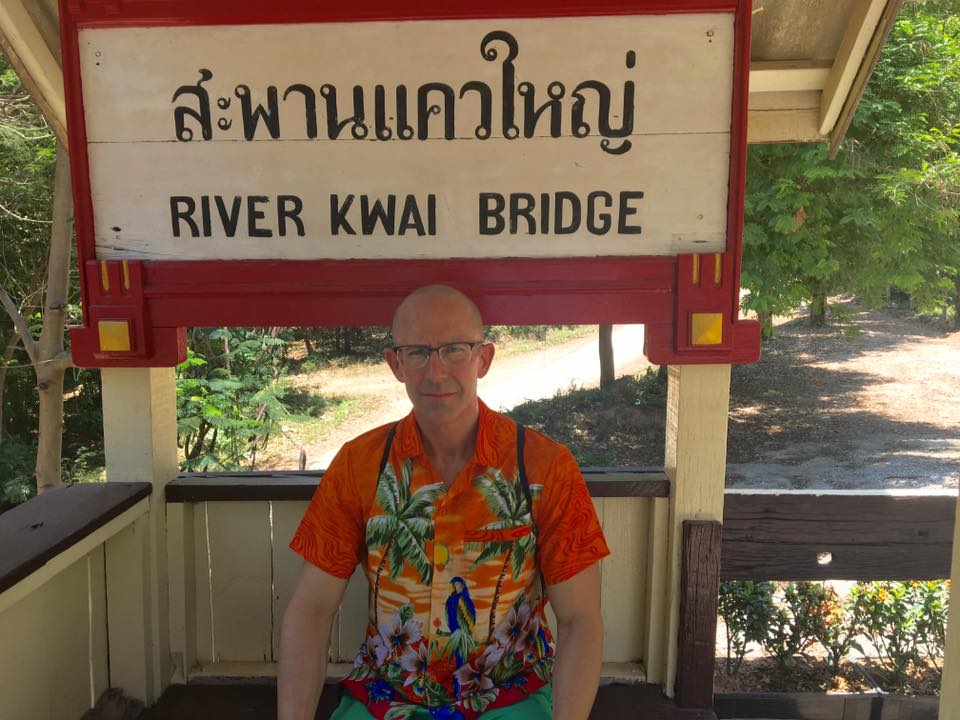
It certainly would be an interesting side-story to the whole TBR saga if there were a whole ‘new’ group of Allied POWs.
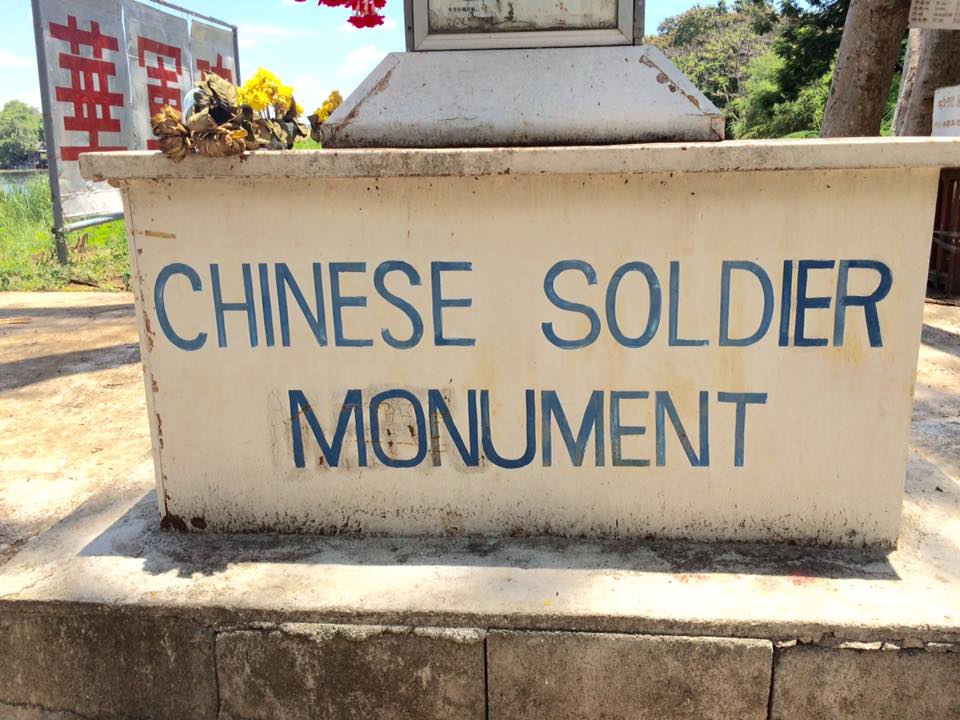

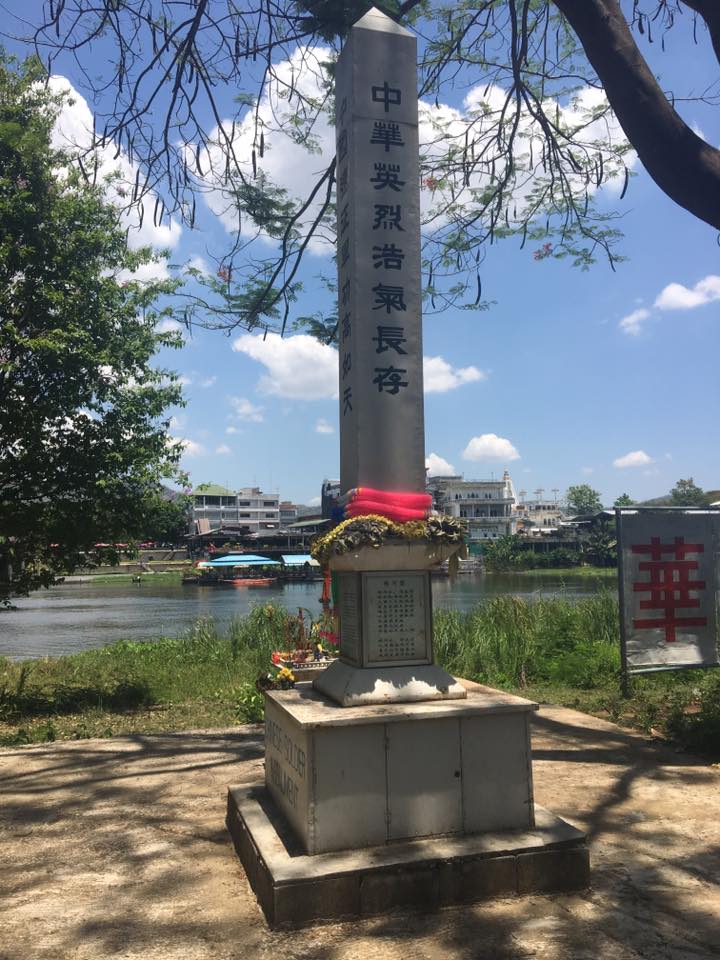
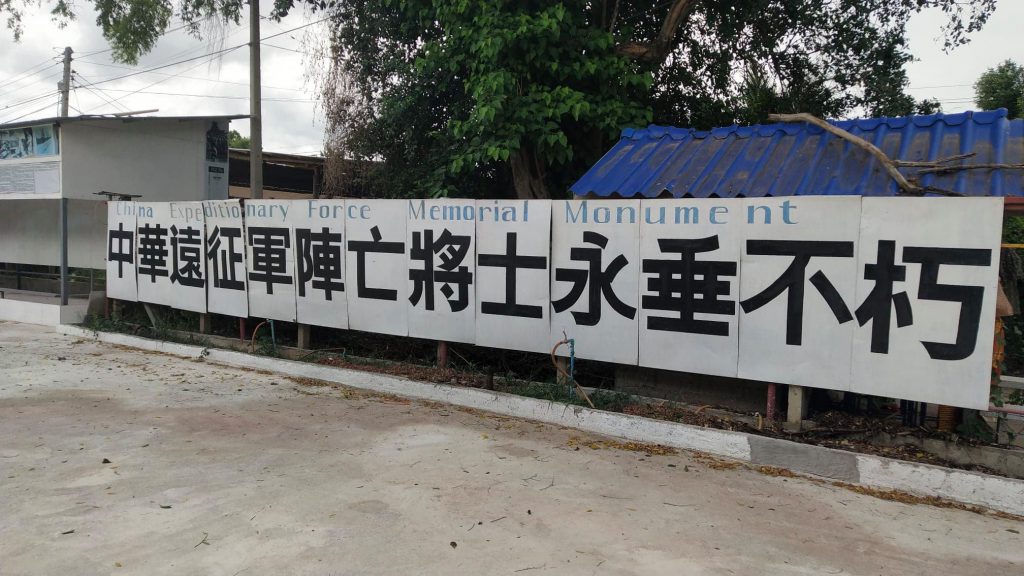
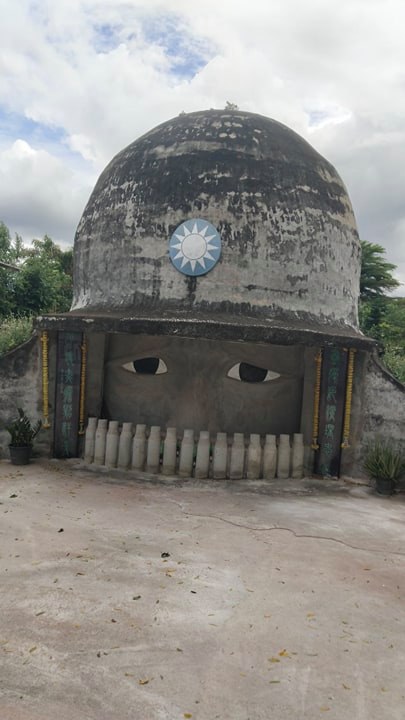
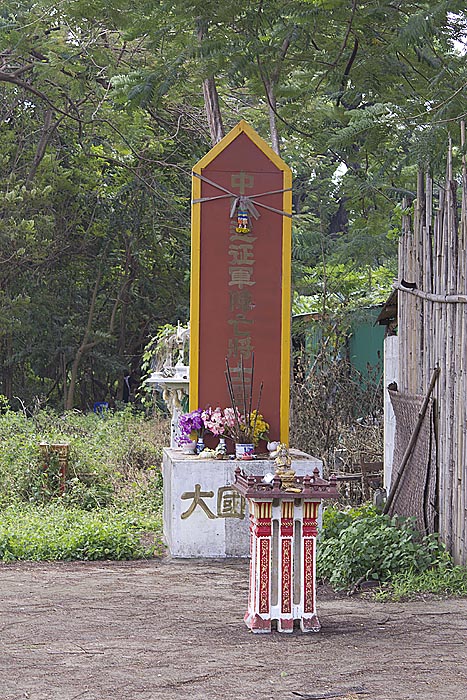



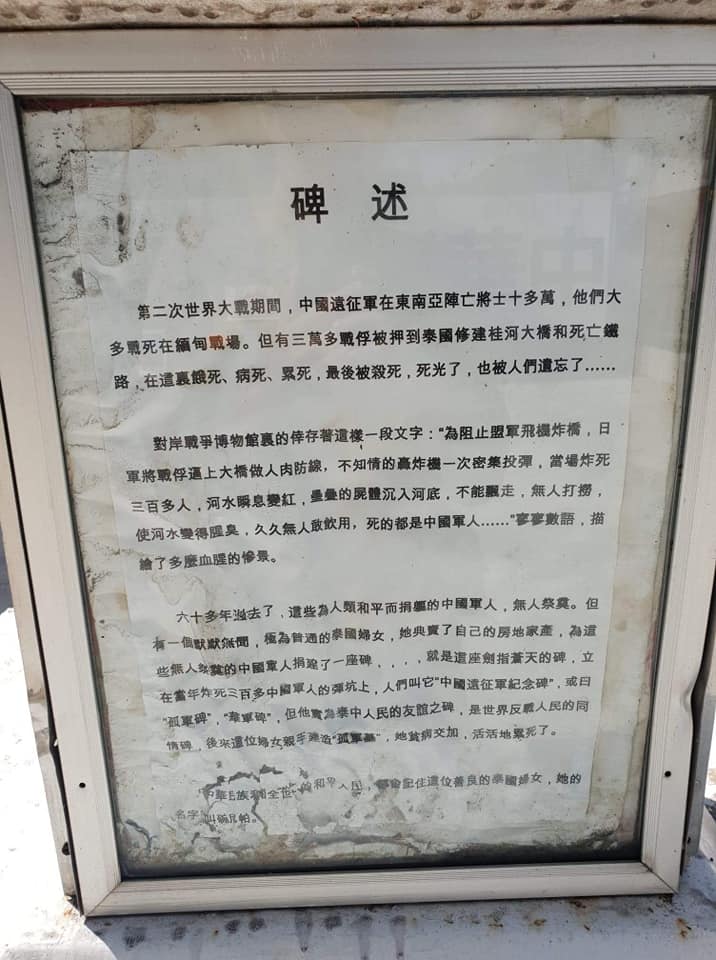


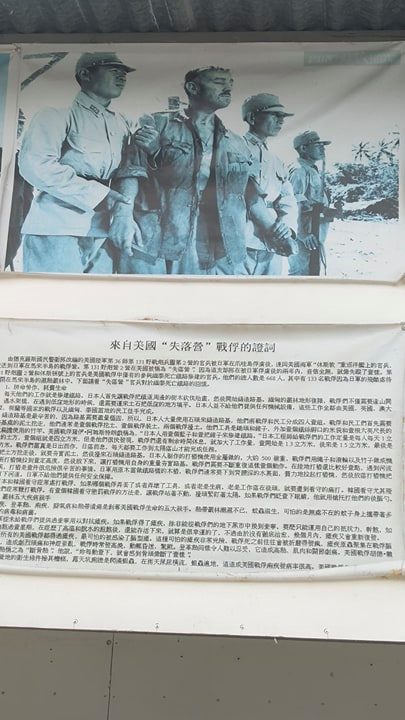
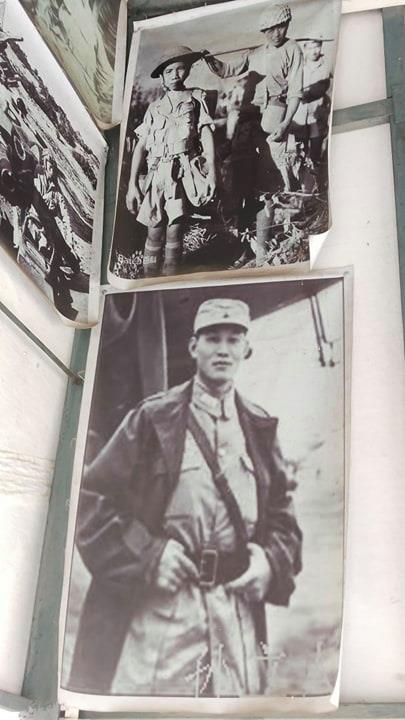

January 11, 2010





And then there is this:
